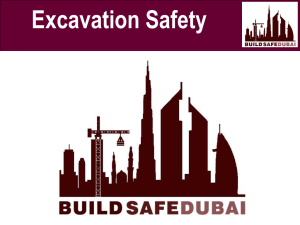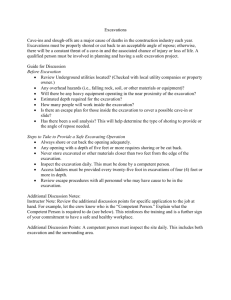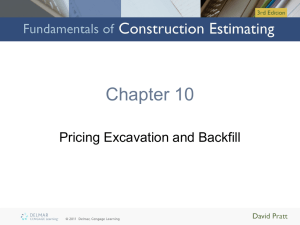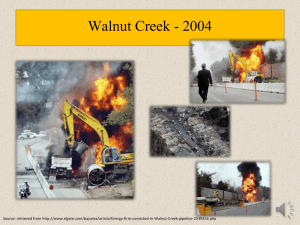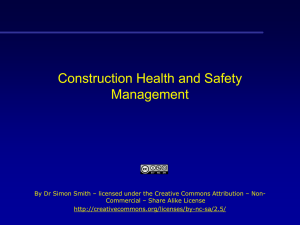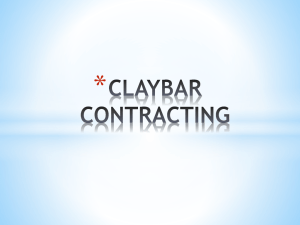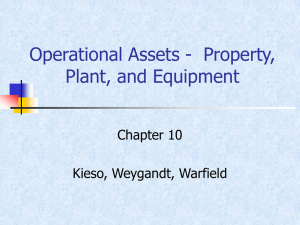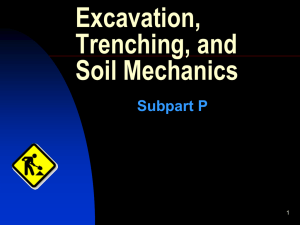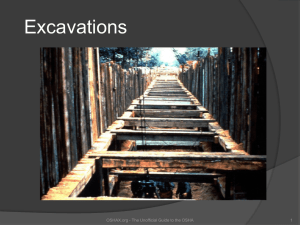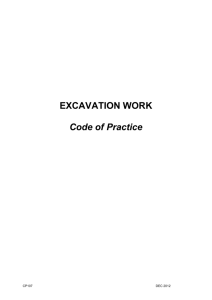May 2013....Excavations Presentation
advertisement
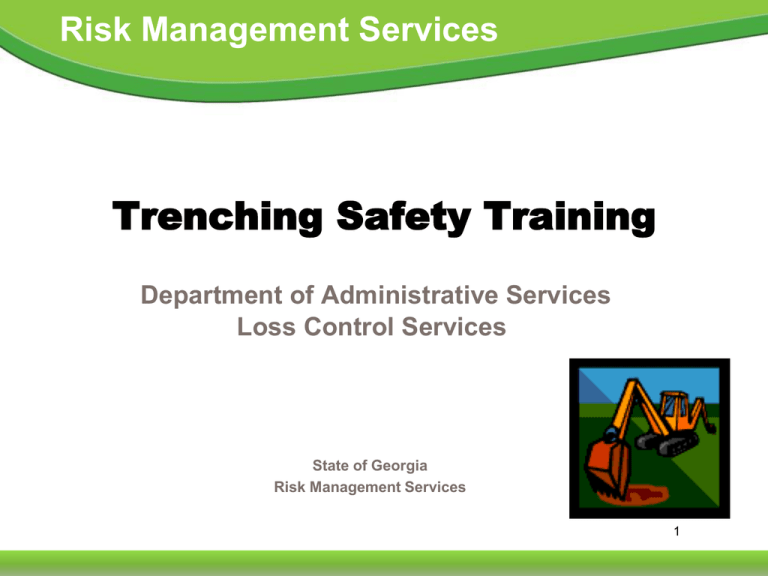
Risk Management Services Trenching Safety Training Department of Administrative Services Loss Control Services State of Georgia Risk Management Services 1 Risk Management Services Excavation Hazards Cave-ins are the greatest risk Other hazards include: • Asphyxiation due to lack of oxygen • Inhalation of toxic materials • Fire • Moving machinery near the edge of the excavation can cause a collapse • Accidental severing of underground utility lines 2 Risk Management Services Injury and Death • Excavating is one of the most hazardous construction operations. • Most accidents occur in trenches 5-15 feet deep. • There is usually no warning before a cave-in. 3 Risk Management Services Definitions • Excavation – a man-made cut, cavity, trench, or depression formed by earth removal. • Trench – a narrow excavation. The depth is greater than the width, but not wider than 15 feet. • Shield – a structure able to withstand a cave-in and protect employees. • Shoring – a structure that supports the sides of an excavation and protects against cave-ins. • Sloping – a technique that employs a specific angle of incline on the sides of the excavation. The angle varies based on assessment of impacting site factors. 4 Risk Management Services Focus of Training The greatest risk at an excavation How to protect employees from cave-ins Factors that pose a hazard to employees working in excavations The role of a competent person at an excavation site 5 Risk Management Services Protection of Employees Employees should be protected from cave-ins by using an adequately designed protective system. Protective systems must be able to resist all expected loads to the system. 6 Risk Management Services Requirements for Protective Systems A well-designed protective system includes: Correct design of sloping and benching systems and Correct design of support systems, shield systems, and other protective systems Plus Appropriate handling of materials and equipment Plus Attention to correct installation and removal Equals 7 Protection of employees at excavations Risk Management Services Design of Protective Systems The employer shall select and construct: ▪ slopes and configurations of sloping and benching systems ▪ support systems, shield systems, and other protective systems • Shield – can be permanent or portable. Also known as a trench box or trench shield. • Shoring – such as metal hydraulic, mechanical or timber shoring system that supports the sides. • Sloping – form sides of an excavation that are inclined away from the excavation. 8 Risk Management Services Protect Employees Exposed to Potential Cave-ins • Slope or bench the sides of the excavation; • Support the sides of the excavation; or • Place a shield between the side of the excavation and the work area. 9 Risk Management Services Cave-in Hazard This excavation has inadequate support posts and egress access. Inadequate protective system 10 Risk Management Services Inadequate Protective System This worker is in a trench with no protective system, that is not sloped or benched and has no means of egress. 11 Risk Management Services Factors Involved in Designing a Protective System • • • • Soil classification Depth of cut Water content of soil Changes due to weather and climate • Other operations in the vicinity 12 Risk Management Services Shoring • General ▪ Provides a framework to work in ▪ Uses wales, cross braces and uprights ▪ Supports excavation walls • OSHA tables provide shoring data ▪ Must know soil type ▪ Must know depth and width of excavation ▪ Must be familiar with the OSHA Tables 13 Risk Management Services Trench Shield A trench shield was built around this work area. 14 Risk Management Services Hydraulic Trench Support • Using hydraulic jacks, the operator can easily drop the system into the hole. • Once in place, hydraulic pressure is increased to keep the forms in place. • Trench pins are installed in case of hydraulic failure. 15 Risk Management Services Materials and Equipment • Equipment used for protective systems must not have damage or defects that impair function. • If equipment is damaged, the competent person must examine it to see if it is suitable for continued use. • If not suitable, remove it from service until a professional engineer approves it for use. 16 Risk Management Services Protection from Vehicles • • • • • Install barricades Hand/mechanical signals Stop logs Grade soil away from excavation Fence or barricade trenches left overnight 17 Risk Management Services Spoils • Don’t place spoils within 2 feet from the edge of the excavation. • Measure from the nearest part of the spoil to the excavation edge. • Place spoils so rainwater runs away from the excavation. • Place spoil well away from the excavation. 18 Risk Management Services Other Excavation Hazards Water accumulation Oxygen deficiency Toxic fumes Access/Egress Falls Mobile equipment 19 Risk Management Services Water is Hazardous When water is present in an excavation, it is extremely hazardous to enter. Note that these workers are not wearing hardhats to protect them from materials falling into the trench. 20 Risk Management Services Water = Cave-in Hazard These workers must be protected from cave-in. Note the water in the bottom of the trench. This is a very hazardous condition! 21 Risk Management Services Hazardous Atmosphere Test excavations more than 4 feet before an employee enters the excavation, in this order, for: ▪ Oxygen deficiency ▪ High combustible gas concentration ▪ High levels of other hazardous substances 22 Risk Management Services Means of Egress This ladder does not meet the requirements of the standard A stairway, ladder, or ramp must be present in excavations that are 4 or more feet deep, and within 25 feet of the employees. The ladder should extend 3 feet above the excavation. 23 Risk Management Services Access and Egress These two ladders which are lashed together are not an adequate means of egress. The ladder should extend 3 feet above the top of the excavation. 24 Risk Management Services Protection from Falls, Falling Loads, and Mobile Equipment • • • • • Install barricades. Use hand/mechanical signals. Grade soil away from excavation. Fence or barricade trenches left overnight. Use a flagger when signs, signals and barricades are not enough protection. 25 Risk Management Services Protection from Equipment Employees are not allowed under loads handled by lifting or digging equipment. Workers must either stand away or otherwise be protected from any vehicle being loaded or unloaded to avoid spilling or falling material. 26 Risk Management Services Competent Person Must have had specific training in and be knowledgeable about: Soils classification The use of protective systems The requirements of the standard Must be capable of identifying hazards, and authorized to immediately eliminate hazards. 27 Risk Management Services Inspections of Excavations A competent person must make daily inspections of excavations, areas around them and protective systems: • Before work starts and as needed; • After rainstorms, high winds or other occurrences which may increase hazards; and • When you can reasonably anticipate an employee will be exposed to hazards. 28 Risk Management Services Inspections of Excavations If the competent person finds evidence of a possible cavein, indications of failure of protective systems, hazardous atmospheres, or other hazardous conditions: • Exposed employees must be removed from the hazardous area. • Employees may not return until the necessary precautions have been taken. 29 Risk Management Services Site Evaluation Planning Before beginning excavation: Evaluate soil conditions. Construct protective systems. Test for low oxygen, hazardous fumes and toxic gases. Provide safe in and out access. Contact utilities. Fissure Determine the safety equipment needed. 30 Risk Management Services Summary The greatest risk in an excavation is a cave-in. Employees can be protected through sloping, shielding, and shoring the excavation. A competent person is responsible to inspect the excavation. Other excavation hazards include water accumulation, oxygen deficiency, toxic fumes, falls, and mobile equipment. This training does not make you a “Competent Excavation person”. Experience and training are required. 31 Risk Management Services QUESTIONS??? Contact Information Hiram S. Lagroon, BS Chief Loss Control & Safety Officer (404) 463-6309 Hiram.Lagroon@doas.ga.gov Charles G. Lawrence, III, CSP, REM, ARM-P Chief Loss Control & Safety Officer (404) 657-4457 Charles.Lawrence@doas.ga.gov 32
